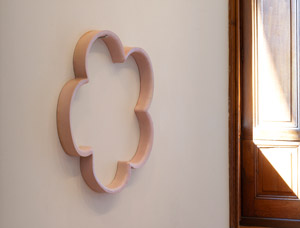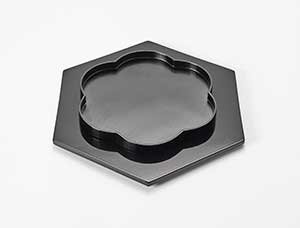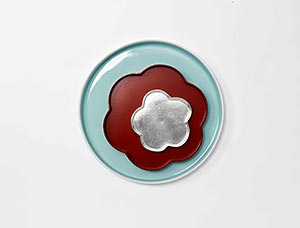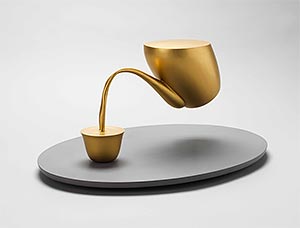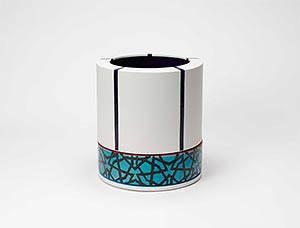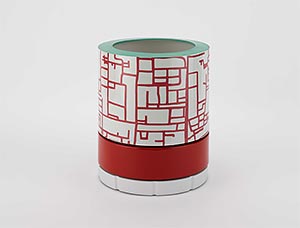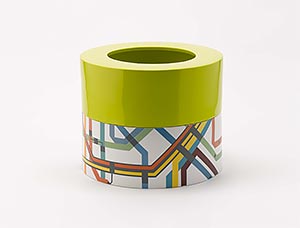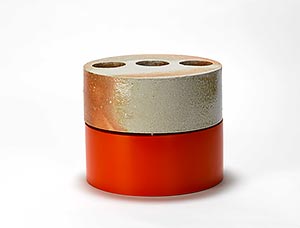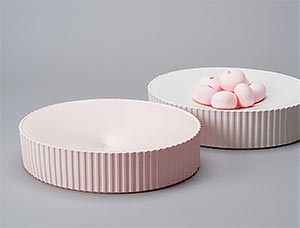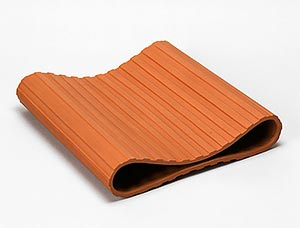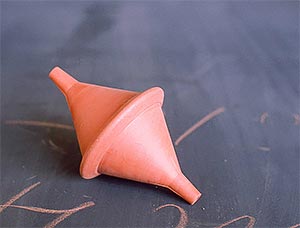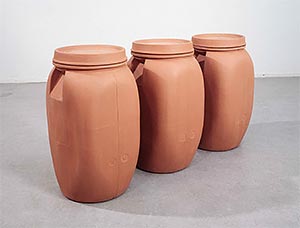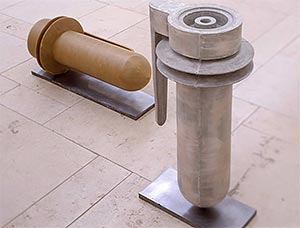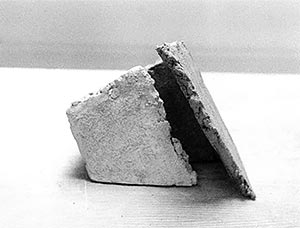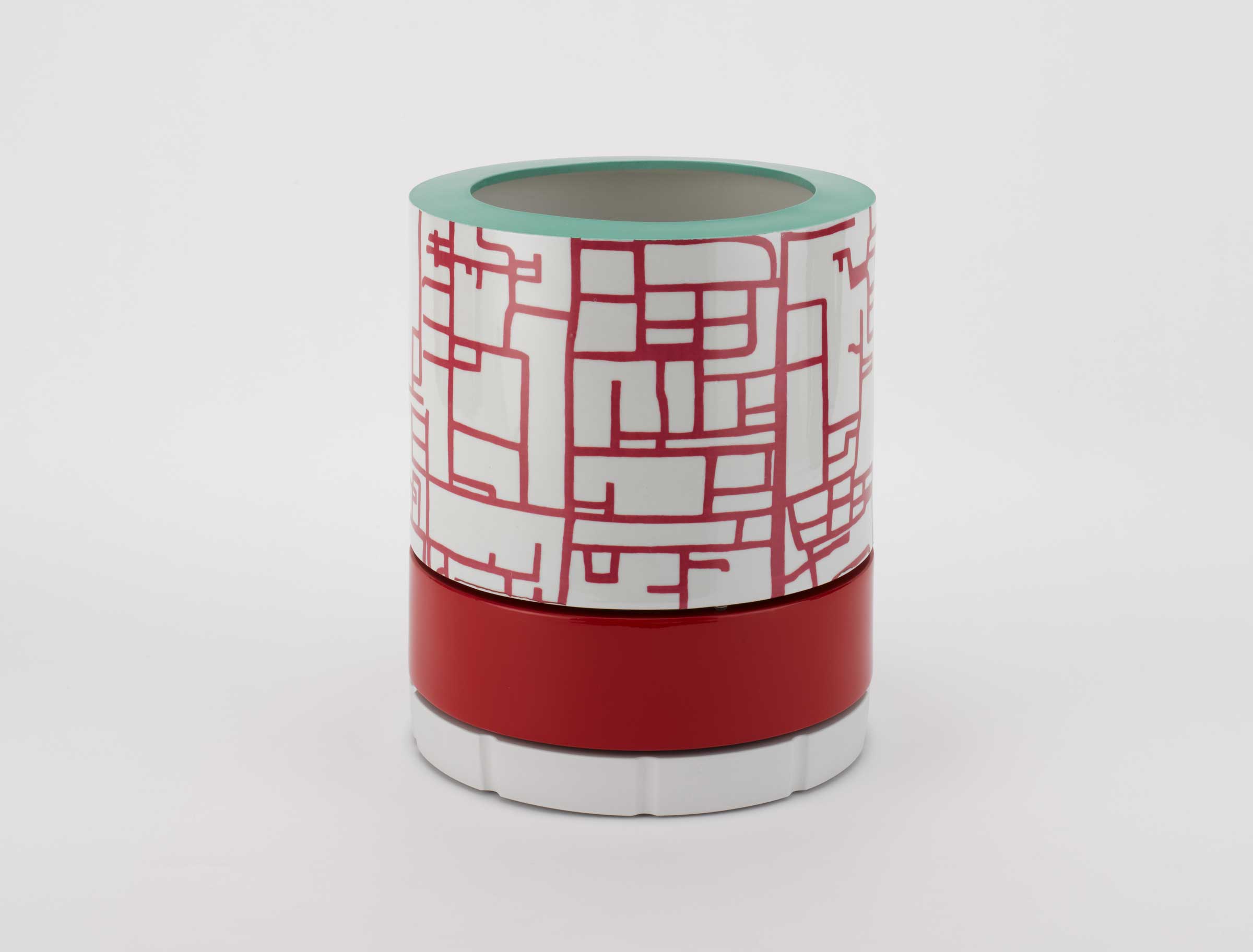
Hutong | 2009–2011
«Hutong» – or
The Absolute Present
A ceramic tower made of cylindrical containers in bold colours. The three cylinders of different height, of uniform shape, staple goods in the non-conventional sense, form a compact, formal unit. But despite its seemingly self-enclosed structure, the work consists of a series of autonomous receptacles.
The base is formed by a shallow dish with a curved rim, a ceramic body in pure white. Set upon this is a cylinder with a narrow rim in radiant red. And these are capped by a tall container with a strongly drawn-in rim and decorated with an elaborate decal in one of three different shades of pink, while the rims are done variously in green, pale blue and chartreuse. The colours are sassy, the shape of the containers rhythmic, the combination is quite sophisticated – but what does hutong convey?
In 2008 Margareta Daepp travelled to Beijing. She lived in a hotel that used to belong to a famous opera singer and his family. The main building with its central courtyard, which contained a beautiful garden, was flanked by smaller buildings which likewise formed courtyards. Depending on the space requirements of the growing families, additional sections could be built without problem onto the various parts of the building. This hotel is located in one of the small neighbourhoods that can still be found in Beijing, the so-called hutongs.
Originally they dominated the look of the city. All of the tiny streets, the winding alleyways, the mostly single-storey houses, the shops and the temples were linked together as a neighbourhood. Hutong was the architecture that gave the city its structure, that gave urban order to the chaos. It is more or less the primal form of the Chinese metropolises. In the wake of the radical modernisation of the capital came the systematic demolition of a great many old hutongs, which had to make way for the civic planning and a modern China.
The title Hutong is however much more than a broad reference to Chinese culture. In this work the constructional principle of the neighbourhoods has been translated as a graphic pattern into a sculptural principle that informs a modern system of permutation. The at first baffling system of decorative lines on the tall cylindrical container turns out to be a map of a hutong. Its key function lies in the graphic mediation of decoration and of the significant content of the work. But then a double game emerges, because at the same time the rich tradition of Chinese ceramics is itself likewise retained in the Hutong series in a variety of citations. The curved rim on the white dish incorporates the specific characteristics of porcelain plates from the Song Dynasty; the lacquer on the half-height receptacle reflects the omnipresent red which is the national colour for love, fortune and joy.
And the striking broad rim on the tall cylinder with its powerful onglaze colours, shimmers in the nuances of historically renowned ceramics from the collection at the Imperial palace in the Forbidden City. The tower-like top-piece in the ceramic set adheres to a strict basic architectural shape, but can also be expanded or decreased without effort thanks to the variability of its parts. Compared to the chaotic, two-dimensional, linear layout of the hutongs, the modular form instils order. Through the choice and integration of these references to Chinese culture, Hutong revolves around the artistic problem of our times. How many stock elements do we need from the past, how many citations must remain recognisable in order that aspects of cultural history are conveyed, and how up-to-date must a ceramic form be in order to transport them to the present?
It is the inherent connotations to ceramic as material that acts here as a time machine. No other material is as strongly bound by tradition to cultural history as ceramic, and must simultaneously fend off the accusation of being old-hat. Not through historification but through a transformation of the rich historical legacy into a contemporary form, Hutong is the absolute present.
Susanne Schneemann

Set yellow-green
2010 | Edition of 7 + 2 AP | Porcelain, ceramic print, car lacquer | Ø 27.5cm, h 33cm

Set yellow-green
2010 | Edition of 7 + 2 AP | Porcelain, ceramic print, car lacquer | Ø 27.5cm, h 33cm

Set light blue
2010 | Edition of 7 + 2 AP | Porcelain, ceramic print, car lacquer | Ø 27.5cm, h 33cm






